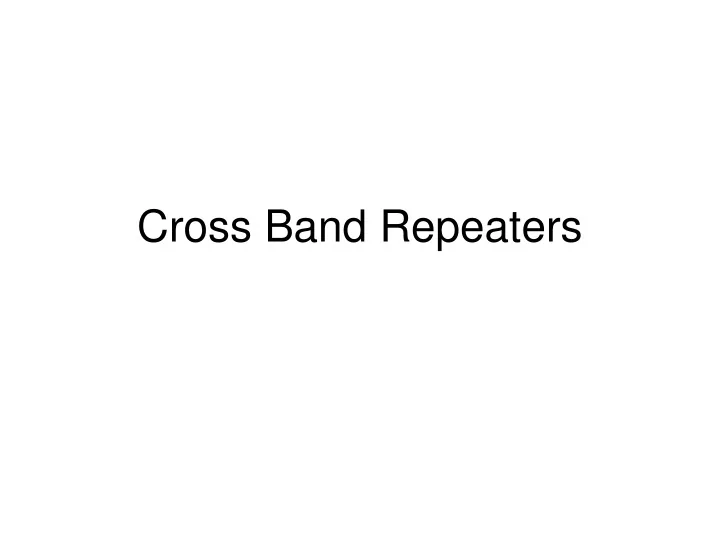

Cross Band Repeaters
Standard Repeater Operation • Operate on one band with specific shift between receive and transmit frequencies. — Two meter shift is 600 KHz — 70 CM shift is 5 MHz
Repeater Block Diagram Receiver Duplexer* Controller Transmitter *Duplexer typically has cavity filter(s)
Why a Cavity Filter? • Cavity filters have high Q and can provide better filtering than LC filters. • Cavity filters also offer opportunity for very narrow trap to isolate the transmit frequency from the receive frequency. • Without the sharp filters, the transmitter would de-sense the receiver.
What is a Cross-Band Repeater? • A cross-band repeater is a repeater that utilizes two bands. In our case, 70CM and 2 meters.
Why Use a Cross-Band Repeater? • It allows use of standard radios such as a mobile radio to be used as a repeater (so long as the radio has cross-band capability). • Cross-band operation works because the frequency difference between the transmit and receive frequencies are sufficiently distant in frequency to eliminate receiver de- sensing.
Why Would MIRO Need a Cross- Band Repeater? • In the event of a loss of our standard repeaters, a cross-band repeater would give us better geographical coverage than simplex frequencies.
How Would MIRO Use the Cross Band Repeater? • Net control would operate on 70 CM. • Field operators would operate on 2 M. • Both frequencies would be operated as simplex frequencies.
What Frequencies Will MIRO Use? • 70 CM — 440.350 MHz • 2 M — 147.160 MHz • 440.350 is a frequency that MIRO currently does not use. • 147.160 is our 2 M receive frequency. We can use that frequency because we assume that the repeater is not operational when we need to use a cross band repeater..
Frequencies (cont.) • To use the 2 M frequency, it will be necessary to set up a memory position in your HT to operate on 147.160 MHz simplex. You can’t use the repeater memory because while you would receive on 147.160 MHz you would transmit on 147.760 MHz.
How Does it Function? • NC makes a call on 440.350 MHz. • The cross-band repeater in a mobile unit receives the 440.350 MHz signal and repeats it at 147.160 MHz. • Field communicators receive it on 147.160 MHz and answer on the same frequency.
How Does it Function? (cont.) • The mobile cross-band repeater receives the 2 M frequency and retransmits it on 70 CM. • NC receives the signal on 70 CM. • Note: No CTCSS tone is needed.
Mobile Unit • The mobile unit will be located in some advantageous location that will allow the best coverage possible on Mercer Island. • The mobile unit can use an enhanced antenna that will result in better coverage than a mag-mount antenna.
Enhanced Antenna I built a copy of the Vashon Island J-Pole antennas (with modifications) for use as the enhanced antenna.
Antenna Modification The modification was to increase the mast mounting area on the angle bracket.
Then I modified a trailer hitch adapter by adding a 1” diameter aluminum rod to allow for antenna mounting.
Trailer hitch adapter mounted to vehicle.
The antenna mast has two pieces. One mounts to the antenna and the other (smaller) is a long mast to provide additional height. The two pieces slip together and are held With bolts and thumb nuts.
I added two support pieces that temporarily clamp to the rack on my vehicle when the antenna is in place.
Enhance antenna installed on vehicle.
Questions or Comments
Recommend
More recommend